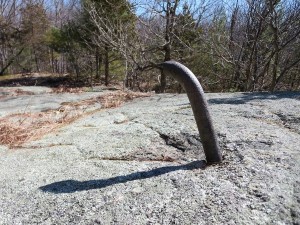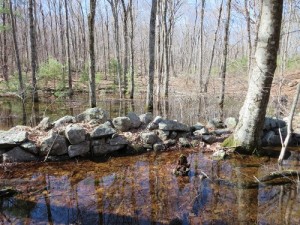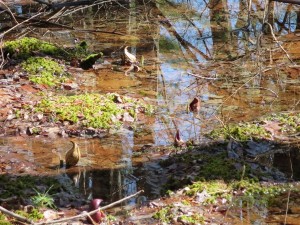Before the caterpillar invasion, I went on a couple of springtime walks. I have often avoided spring walks in the past due to my concern over ticks, but this year I had permethrin-treated clothing. That made me feel a little bit safer. The snow had finally melted and it was a joy to be outside. Here’s what I saw on my first spring walk.
I’ve shown this scene of the quarry top in the winter. Now you can see it in spring. It was mid-April and there were no leaves on the trees yet.
As I walked around this area, several things grabbed my attention. First, there was a ton of poop on the ground. It was everywhere. I really had to watch my step. Why was there so much here? My guess is that it sat on top of and between layers of snow, and when the snow finally melted, it was left like this. Some of it might have been washed down from above, too.
Second, I saw a pair of butterflies. They were fluttering around me and one of them paused on a rock below me, so I took its picture.
I researched the markings on the butterfly and have identified it as a mourning cloak. The mourning cloak is a long-lived butterfly. It lives nearly a year (compare that to the luna moth, which lives only about a week!). The mourning cloak overwinters where it lives, rather than migrating somewhere warmer, so it is often the first butterfly seen in the spring.
Third, there is a broken piece of metal sticking out of the rock. I’ve always wondered what it might have been for. Maybe it was a hook. Now it does nothing but cast a fine shadow. Perhaps it should be turned into a sundial.
I took the long route so that I could visit the pine forest. That area is always boggier, and along the way I saw many flooded spots.
I recently read an interesting story about the rock walls of New England. It said that a guy smuggled some merino sheep (prized for their fine wool) out of Europe in the early 1800s and brought them to Vermont, which kick-started a wool boom in the Northeast. Small sheep farms, all with rock wall boundaries, sprung up everywhere.
The story implied that this was how most of New England’s rock walls arose. But when I researched it on-line, other sourced claimed that tilling the land exposed the rocks. The rocks had to be put somewhere, naturally, so the farmers lugged them to the boundaries of their lands and turned them into fences. That sounds reasonable. But this particular area is just a big rock hill, not a great place for farming, so I think the sheep story is more fitting. Plus it’s just more fun.
The flooding was at times a problem during my walk, because parts of the path had become small ponds. The flooding was not a problem for certain plants, though. The peculiar flowers in the picture below were certainly thriving.
I wasn’t sure what they were at first. It took me a while to find one that was close enough to dry land that I could get a good photograph. This is what they look like closer up.
 Seeing it like this you can guess its identity. Notice the spike of leaves coming up? In the early springtime and in a New England swamp, a spike like this would almost have to be skunk cabbage, and so it is. Strangely, the flowers bloom before the leaves come up. Also interesting about this flower is that it supposedly produces its own heat, which is why it can bloom so early. Bizarre. It amazes me the things you find out if you investigate!
Seeing it like this you can guess its identity. Notice the spike of leaves coming up? In the early springtime and in a New England swamp, a spike like this would almost have to be skunk cabbage, and so it is. Strangely, the flowers bloom before the leaves come up. Also interesting about this flower is that it supposedly produces its own heat, which is why it can bloom so early. Bizarre. It amazes me the things you find out if you investigate!
Now I will leave you with a cheerful picture of some old beech leaves. Oh, I know I have posted pictures of beech leaves before, at least one, two, three times. I can’t seem to help myself. They’re pretty, often the prettiest things in the woods at the gloomiest times of year. I took this picture because the leaves, in this formation, and with the light shining on them just so, reminded me of strings of Chinese lanterns.







